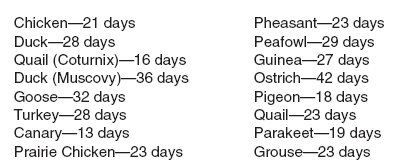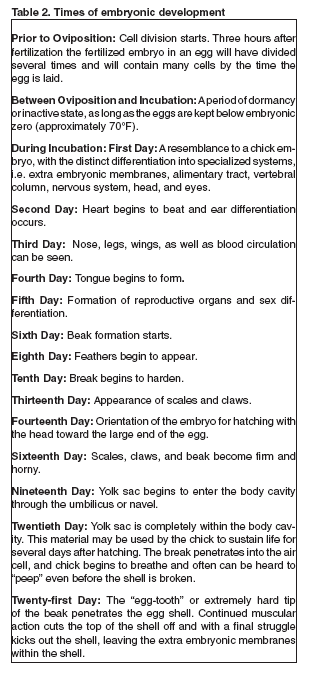



Artificial Incubation
An introduction to incubation times and optimal conditions in a number of avian species by Joe G. Berry, Extension Poultry Specialist at Oklahoma State University in a Fact Sheet published in May 2007.Artificial incubation of poultry eggs is an ancient practice. Aristotle writing in the year 400 B.C. told of Egyptians incubating eggs spontaneously in dung heaps. The Chinese developed artificial incubation at least as early as 246 B.C. These early incubation methods were often practiced on a large scale, a single location perhaps having capacity of 36,000 eggs.
The application of incubation principles was a closely guarded secret, passed from one generation to the next. The proper temperature was judged by placing an incubating egg in one’s eye socket for accurate determination. Temperature changes were effected in the incubator by moving the eggs, by adding additional eggs to use the heat of embryological development of older eggs, and by regulating the flow of fresh air through the hatching area. Humidity was evidently not a problem as primitive incubators were located in highly humid areas, and the heat source, often burning materials, furnished water around the eggs. Turning was done as often as five times in a 24-hour period after the fourth day of incubation.
The construction, use, and patent of artificial incubators in the United States dates from about 1844. The Smith incubator, virtually a large room with fans for forcing heated air to all parts of the incubation chamber, was patented in 1918. It was the forerunner of today’s efficient, large-scale incubator, used for the hatching of chicken, turkey, duck, and other eggs.
Length of Incubation Periods
Incubation periods vary for different species of birds. In general, the larger the egg the longer the incubation period. However, there are individual differences. The incubation period may also vary with the temperature and humidity within the incubator. Average incubation periods for some species are:

Incubation Conditions
Temperature
Temperature is extremely important during incubation. Variations of more than one degree from the optimum will adversely affect the number of eggs that will successfully hatch. In sectional or home-type incubators the temperature will vary considerably between the top and the bottom of the egg. With these types of incubators a temperature at the top of the eggs of 101°F for the first week, 102°F for the second week, and 103°F till hatching gives the best results with eggs of most species.
In modern, commercial, forced-draught incubators, a temperature of 99-100°F is maintained throughout the incubation period. Most operators find that in the very large machines some provision must also be made for cooling to maintain this constant temperature. Embryonic development produces considerable heat. If this heat is not dissipated, injury to the embryos may occur.
Humidity
Eggs lose water during the incubation period, and the rate of loss depends on the relative humidity maintained within the hatching chamber. Metabolic balance must be maintained throughout the incubation period. Thus, humidity outside a relatively narrow range will affect the number of successfully hatched eggs.
Optimum growth for most species requires a relative humidity of 60 percent until the eggs begin to pip, after which the relative humidity should be raised to 70 percent. Best results occur with turkeys when these humidities are raised 2 to 3 percent. Under most Oklahoma conditions, moisture must be added to the hatching chamber to reach these relative humidity levels. This can be done by placing an open pan of water in the same area with the eggs. In sectional or convectional type incubators, it may be necessary to increase the water surface by suspending a piece of cloth from the water, providing wick action.
Relative humidity can be gauged by wrapping a wet cotton cloth around the bulb of a thermometer and suspending it in the hatching compartment. Due to evaporation, the “wet” bulb thermometer will have a temperature below that of a dry bulb thermometer in the same compartment. Table 1 shows the relative humidity for selected temperature readings.

Position and turning of eggs
Eggs should be placed in the incubation compartment large ends up for best results. However, a fairly good hatch can be obtained if the eggs are placed on their sides. An extremely poor hatch will occur if the eggs are placed in the incubator small end up.
The eggs must be turned several times a day for best hatchability. This will ensure that the embryo will not stick to the shell. The turning should be repeated throughout the entire 24-hour day. However, the night turning may be eliminated as long as there is a late evening and an early morning turning. Eggs should be turned at least four times during each 24-hour period. In large commercial machines, turning is mechanically done, controlled by a time clock.
The eggs should be turned through a 90-degree plane as gently as possible. Turning should continue until one to three days prior to hatching and or until the eggs has “pipped;” position or turning will then have no effect on hatching.
Ventilation
Since the developing embryo receives oxygen from the atmosphere and releases carbon dioxide, the capability for ventilation must be incorporated in the incubator. The more eggs in the incubator compartment and the older the embryo, the more oxygen is required.
Embryonic Development
Embryo development from the single fertilised cell to the self-sustaining animal in a relatively short span is an interesting but complex process. Because of various incubation periods for different avian species, characteristic elements in the developing embryo occur at slightly different times. For the chicken, Table 2 indicates significant changes and the day on which each change is evident.
Embryo Mortality
Eggs can fail to hatch for many reasons. Among these are inadequate diet of the hen, incorrect environment within the incubator, and malposition of the embryo within the egg.

May 2009








